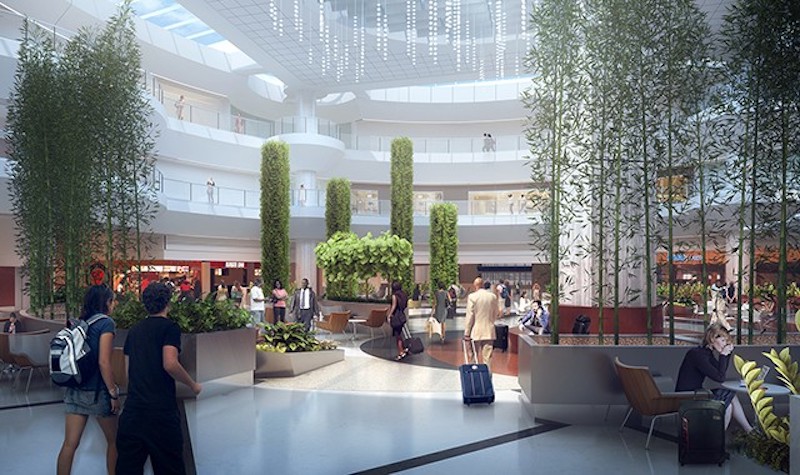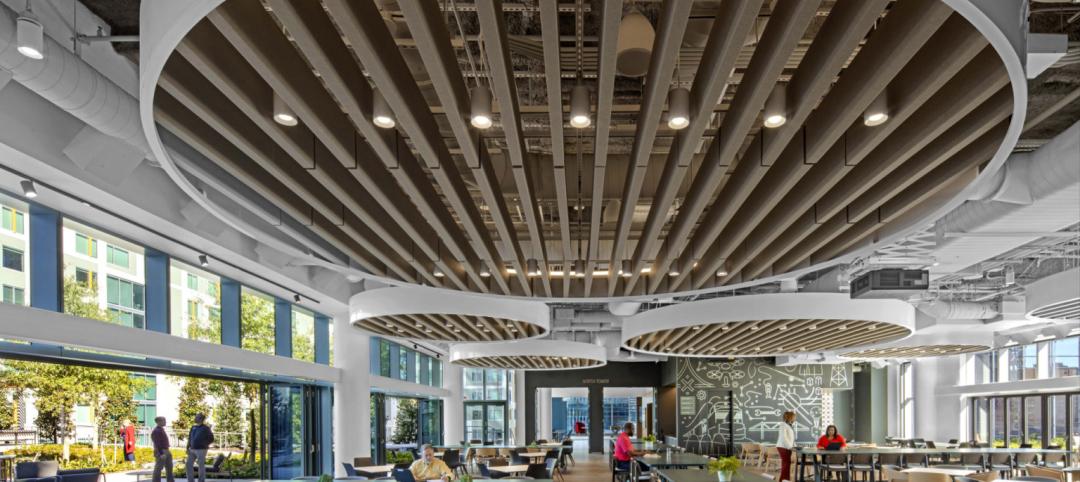In many ways, 2016 was a breakout year for virtual reality in the design professions. After years of speculation and buildup, manufacturers such as HTC, Oculus, and Microsoft released powerful head-mounted displays that gave designers and clients a truly immersive and interactive 3D experience. At the same time, new software such as Lumion, Enscape3D and InsiteVR made it relatively simple for architects and engineers to convert building information modeling (BIM) data into a virtual reality experience.
At HOK, we first began experimenting with VR a couple years earlier, testing early prototype headsets and asking ourselves how this evolving technology would one day enhance the design process. Fast forward to today (entering the second quarter of 2017) and architects and designers in our worldwide offices are now using VR technology on a daily basis to discover new insights into their design ideas.
Given the dizzying speed in which the technology has caught on, it’s worth taking a moment to look at what we’ve learned to date about VR and discuss how it fits into the future of architecture and design.
VR AS A COMMUNICATION TOOL
As architects, we’re accustomed to looking at a design—be it a rendering, a sketch or a physical model—and interpreting how a building or landscape would look and feel spatially as a finished project. The same isn’t necessarily true of our clients, who aren’t creating and interpreting designs on a daily basis. Virtual reality tools give our designers a powerful aid for explaining ideas and concepts to clients and other stakeholders. It’s this use—as a presentation or communication tool—that is for now VR’s greatest benefit.
Here’s an example. A client visiting our Philadelphia office needed additional help interpreting a design after being presented several static renderings of a project. In search of a new tactic, Kevin Hollenbeck, one of our project designers, turned to virtual reality.
“We decided to show the client some 360-degree panorama views that put them in the space with all those materials and the model constructed around them,” says Hollenbeck. “The VR experience provided them a clearer understanding of what it would be like in that space. We only had to do the VR demonstration once. Immediately the client got it.”
Peter Ruggiero, design principal at our Chicago office, relays a similar story. Last fall his team took plans they’re working on for a new police headquarters and generated a VR version to show the police chief and other stakeholders.
“They found the experience to be rewarding in terms of confirming what they thought the building would be like spatially,” says Ruggiero.
Now our design professionals at HOK are using VR to aid clients’ understanding of projects large and small and across practice types, including interior design, sports arenas, aviation and healthcare.
VR experiences can be had with inexpensive headsets, such as the cardboard version to the right. Others require more advanced devices.
THE VARYING DEGREES OF VR
Over the past 18 months, rapid advances in technology have greatly expanded the field of VR hardware and software and lowered the price to get started. VR headsets such as Google Cardboard (and similar devices that incorporate a smartphone as the display) can be had for $20 or less. More advanced head-mounted displays, such as the HTC Vive, start at around $800. The self-contained, head-mounted computer and holographic display of the Microsoft HoloLens offers a head start into augmented reality (AR) development starting at $3,000. The more advanced VR experiences also require investment in computers with powerful graphical processing units to generate realistic shadows, lighting and materials in real time along with advanced gaming-engine software that can render 3D imagery at speed.
At HOK, we’ve incorporated the use of both simple and sophisticated technology to fashion a sort of small, medium and large approach to deploying virtual reality methods. Here’s how that works:
— “Small” approach: The easiest, least expensive VR experience requires the quick additional step of rendering a spherical panorama from within our BIM software. This panorama can be displayed on a smartphone and placed into a VR headset to give users a static view of being inside a rendering. Though the user cannot navigate through this static model, they can get a 360-degree view of the space. (View example.)
— “Medium” approach: This approach takes a 3D-design model and exports it to powerful gaming-engine software. When coupled with a VR headset and joystick, such as the HTC Vive or Oculus Rift, this “medium-size” approach gives designers and clients the ability to navigate their own way through the model. The design team can also create guided steps through the model to aid in navigation.
— “Large” approach: This method allows users to not only move throughout the model but also interact with it. They can use a virtual laser pointer or joystick to highlight design details and make annotations about design changes or edits.
— Group tour: In addition to the small, medium, and large approaches described above, we also have the ability to generate what is essentially a virtual group tour of the proposed design. Using VR hosting platforms such as InsiteVR, multiple project stakeholders can don head-mounted displays and navigate as a group or independently through the model with an HOK designer as the guide.
Design Technology Manager David Ivey instructs an HOK designer how to navigate a model using the HTC Vive.
WHAT’S NEXT: VR AS A DESIGN TOOL
In those early days of 2014, when HOK’s design technology team was first testing the development version of Oculus Rift (Oculus was later acquired by Facebook) and other VR equipment, we could clearly see how the technology would benefit our clients. Lately, though, we’re seeing a much more powerful use-case for VR as a creative tool for our architects and designers.
Here’s an example of how that’s playing out inside HOK: On a recent afternoon in our St. Louis office, a team of designers gathered in front of a flat-screen TV in the studio’s public workspace. For weeks the team had been working on plans for a proposed MLS soccer stadium. Now it was time to view the project in virtual reality.
Senior Design Professional Andrew Zell strapped on an HTC Vive headset and for the first time “entered” the model as the rest of the team followed his movements through the stadium on the TV screen. Like most everyone who experiences a rendering in virtual reality, Zell was immediately taken by the size of and scale of being immersed in the design model. Soon, though, he was using the VR experience to identify issues—such as the placement of a scoreboard—that he had not readily noticed during the initial stadium design process.
Looking on—and ensuring that Zell didn’t trip over the wires connected to the headset and joysticks—was Eli Hoisington, design principal at the St. Louis office, who had just taken a turn viewing the stadium in virtual reality.
“The ability to validate our design with virtual reality is remarkable,” says Hoisington. “We can get into a challenging space and immediately understand if it feels and works the way we intended. It’s a much faster way to look at design information. I just spent 30 seconds inside this interactive model and saw the amount of information that might have taken 20 different drawings to communicate.”
That same “information” Hoisington describes also represents a current limitation for VR as a design tool. The 3D models that form the core of a VR experience require large amounts of data, requiring designers to be fairly far along in the creative process before they can view a project in virtual reality.
As my colleague Peter Ruggiero more flavorfully puts it, “Right now, VR is really useful for helping clients understand a project that’s pretty well cooked. But as designers, we want to be able to use it like the tasting spoon as we’re actually doing the cooking.”
That day will soon be here. Already software developments are in the works that will make it possible for architects, engineers and others to experience a design in VR without quite as much underlying data. Soon, too, these designers will also be able to build and edit concepts within the VR and AR environments. It’s that use—as a design tool—that holds the real promise for this technology in our profession.
More from Author
HOK | Oct 18, 2024
7 design lessons for future-proofing academic medical centers
HOK’s Paul Strohm and Scott Rawlings and Indiana University Health’s Jim Mladucky share strategies for planning and designing academic medical centers that remain impactful for generations to come.
HOK | Aug 8, 2024
6 design trends for the legal workplace
Law firms differ from many professional organizations in their need for private offices to meet confidentiality with clients and write and review legal documents in quiet, focused environments
HOK | Jun 6, 2024
HOK presents neurodiversity research and design guidelines at SXSW 2024
Workplace experts share insights on designing inclusive spaces that cater to diverse sensory processing needs.
HOK | Apr 2, 2024
How university rec centers are evolving to support wellbeing
In a LinkedIn Live, Recreation & Wellbeing’s Sadat Khan and Abby Diehl joined HOK architect Emily Ostertag to discuss the growing trend to design and program rec centers to support mental wellbeing and holistic health.
HOK | Jan 25, 2024
40 Under 40 Class of 2023 winner Kimberly Dowdell inaugurated as AIA 2024 President
The American Institute of Architects (AIA) has announced the inauguration of Kimberly Dowdell, AIA, NOMAC, NCARB, LEED AP BD+C, Principal and Director of Strategic Relationships at HOK and BD+C 40 Under 40 superstar, as its 100th president.
HOK | Jul 13, 2023
Deep green retrofits: Updating old buildings to new sustainability standards
HOK’s David Weatherhead and Atenor’s Eoin Conroy discuss the challenges and opportunities of refurbishing old buildings to meet modern-day sustainability standards.
HOK | Jun 5, 2023
Office design in the era of Gen Z, AI, and the metaverse
HOK workplace and interior design experts Kay Sargent and Tom Polucci share how the hybrid office is evolving in the era of artificial intelligence, Gen Z, and the metaverse.
HOK | May 5, 2023
9 workplace design trends for 2023
HOK Director of WorkPlace Kay Sargent and Director of Interiors Tom Polucci discuss the trends shaping office design in 2023.
HOK | Apr 4, 2023
6 examples of modern college training facilities
HOK discusses the future of college training facilities, with six design takeaways derived from a discussion between Dan Radakovich, Director of Athletics at the University of Miami, and Trevor Bechtold, Director, HOK’s Sports + Recreation + Entertainment practice.
HOK | Feb 23, 2023
Using data to design the sports venue of the future
Former video game developer Abe Stein and HOK's Bill Johnson discuss how to use data to design stadiums and arenas that keep fans engaged and eager to return.
















